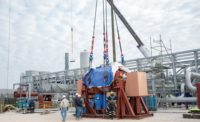When electricity is required, the molten salt is pumped from storage through a heat exchanger that generates high pressure steam similar to a boiling tea kettle. The steam, in turn, drives a 125-MW Alsom generator that produces clean electricity. This process, known as the Rankine cycle, is similar to conventional powerplants, except fuel free. The Crescent Dunes plant will offset an estimated 290,000 metric tons of carbon dioxide annually.
The plant will also use a hybrid aircooled condenser and wet system, requiring less than 600 acre ft of water annually, or about 20% as much as a traditional powerplants, plus 25 million pounds of salt similar to the chemical composition of garden fertilizer. Australia-based WorleyParsons Ltd. is the development plan consultant.
The plant entails placement of a new seven-mile, 230-kV overhead line that patches into NV Energy's nearby Anaconda Moly substation.
The plant will create 50 permanent jobs upon completion. The facility is projected to operate for about 30 years. Tonopah Solar Energy LLC signed a 25-year power purchase agreement with NV Energy, a Las Vegas-based utility provider, in late 2009 to provide about 500,000 MWh per year, or enough electricity for 75,000 households.
Nevada power providers must get 25% of their electricity from renewable sources by 2015, as per a state mandate. But electricity from the Crescent Dunes facility will run about 13.6 cents per kWh, plus a 1% price increase over the next 20 years. The rate is almost double the cost of more traditional coal- and gas-powered options. Crescent Dunes, however, isn't susceptible to peak-use pricing or oil-price volatility.
"The real question is what will natural gas cost in the future?" Smith says. "While fuel prices continue to escalate, we have a fixed price for 20 years and no emissions."


